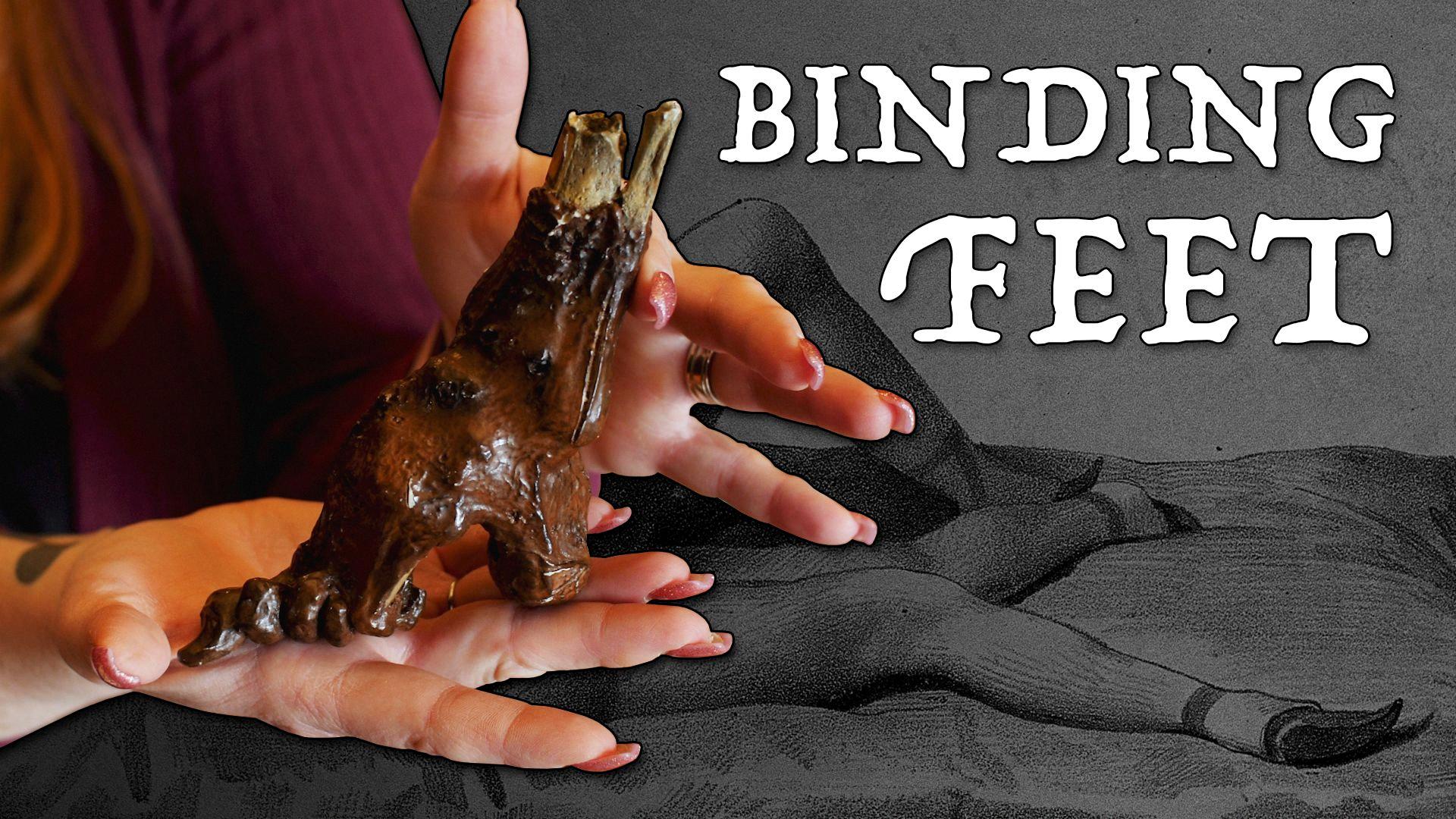Footbinding, a centuries-old practice that originated in China, is an eample of the oppressive forces women have had to endure throughout history. Footbinding was a process of crushing and binding the feet of young girls, often as young as five or six years old. This practice was thought to make women more attractive and marriageable by making their feet appear delicate and small.
The process of foot binding is both painful and physically damaging, yet it persisted in Chinese culture for almost a thousand years. The first step in the footbinding process involved soaking the feet in warm water with herbs and animal blood to soften the skin. Next, the toes were curled under with great force and binding cloths were used to keep them together underneath the sole. This process caused extreme pain for the young girls involved and resulted in permanent physical damage. Not only did this practice case immense physical suffering but it also symbolized deep societal oppression towards women as they were deemed inferior due to their gender.
Footbinding was eventually outlawed in 1912, yet some continued to bind their feet in secret until recently. There are stll survivors of this barbaric practice living today who recall the immense physical pain they endured as children. While footbinding has been banned for over a century now, it’s important to remember this dark part of history and acknowledge how oppressive social forces have subjugated women for centuries all over the world.
It’s also important to recognize that there was an economic rationale behid footbinding that goes beyond mere aesthetics: Young girls were forced into footbinding so that they could stay at home and help make goods like yarn, cloth, mats, shoes and fishing nets which families depended upon for income. This further serves as an example of how deeply entrenched gender inequality is within our society today – not only did these young girls have to endure physical pain but also had no choice but to comply with these oppressive practices in order for their families to survive financially.
Foot binding may be a thing of the past now but it’s important not forget about its painful legacy and take action against any form of gender oppression that persists today. We must continue fighting against all forms of patriarchy which seek to limit women’s rights by any means necessary – whether through physical force or economic exploitation – if we want true gender equality in our society today!
Reversing the Effects of Foot Binding
Unfortunately, reversing foot binding is not possible without extreme pain and physical damage. Foot binding was a painful practice in which the feet of young girls were tightly bound in order to prevent further growth. This was done to give them a dainty look and make them more desirable for marriage. The process entailed breaking the four smaller toes of the foot and then wrapping the remaining one around them, with an additional bandage paced around the arch of the foot. The feet were then bound together with cloth strips, making it impossible for them to move independently.
This cruel practice caused irreversible damage to the feet, leaving them misshapen and unable to support any weight. As a result, women who had undergone this procedure would typically have difficulty walking and would require help with even basic everyday tasks such as dressing or bathing. In terms of reversing foot binding, this is unfortunately not possible since there is no way to undo the damage done by the binding process itself. Despite some modern efforts to create special shoes and other supports that can alleviate some of the difficulties associated with foot binding, tese are merely palliative care solutions rather than actual reversals of its effects.

Source: scmp.com
Steps of Foot Binding
Step 1: Feet were soaked in warm water with herbs and animal blood to soften them.
Step 2: The smaller four toes were curled over to the sole of the foot using great force.
Step 3: Binding cloths were then used to tightly wrap the feet and pull the toes underneath the sole.
Step 4: Finally, an extra layer of cloth was applied to further secure the binding and provide additional support for long-term wear.
Has Foot Binding Been Abolished?
Yes, foot binding is no longer practiced in China. The practice has been officially banned since 1912, and has been heavily discouraged in the century since then. While some isolated cases of foot binding have occurred in secret, it is not widespread. For example, the last known village where foot binding was regularly observed, Liuyicun in Yunnan province, has ceased to practice it. This is due to both the government’s efforts to educate people about the potential dangers of foot binding and a cultural shift away from traditional views on beauty.
The Purpose of Foot Binding
Foot binding was a Chinese practice that began in the 10th century and continued into the 20th century. It involved tightly wrapping a young girl’s feet in cloth strips to restrict their growth, resulting in an unnatural and painful process that eventually left the feet misshapen and just four inches long. This practice was seen as a sign of beauty and wuld make women more desirable for marriage. It also had a clear economic rationale: Foot binding ensured that young girls were able to sit still and undertake labor-intensive activities such as making yarn, cloth, mats, shoes, and fishing nets which were essential to family income. Ultimately, foot-binding became part of Chinese culture, with many families believing it was necessary for marriageability and economic success.
The Practice of Foot Binding in Japan
The Japanese did not practice foot binding. However, they did have an influence on the practice in certain areas. In Dingxian, South of Beijing, Japan discouraged the practice from the beginning of their rule in 1895 and made it gradually illegal from 1911 to 1915. This resulted in no new cases of bound feet among those born ater 1919. In Taiwan, Japanese rule also discouraged foot binding from 1895 and made it illegal from 1911 to 1915.

Source: muttermuseum.org
The Significance of Small Feet in Girls
Small feet on a girl can symbolize femininity, beauty, and delicacy. In some cultures, small feet are also seen as a sign of youth and fertility. In many Asian cultures, foot binding was practiced to achieve the most desirable size of feet for women, which was typically tree to four inches long. In traditional Chinese culture, small feet were seen as a sign of beauty, grace, and status. It has been suggested that small feet signify a woman’s “right measure” in marital relationships; the smaller her feet are (the less she can move around), the less likely she is to leave her husband or wander off.
The Sensation of Foot Binding
Foot binding was an incredibly painful process, as the feet were bound so tightly that they would eventually be reshaped into the ideal shape. The feet were first soaked in hot water to soften them, then the toes were bent under and broken, after which the arch of the foot was broken and folded over itself. The foot was then tightly bound with cloth bandages and a special shoe was worn to keep the foot compressed and maintain its new shape. It is said that those who have undergone foot binding descrie it as feeling like their feet were “burning in fire” or “being cut by knives”. The pain caused by foot binding was so intense that some women passed out from it.
The Duration of Foot Binding
Foot binding was a cultural practice that existed in China from the 10th century until 1949, when the People’s Republic of China was established. It involved tightly bandaging the feet of women to alter their shape for aesthetic purposes. The practice is believed to have originated in the court of Emperor Li Yu of the Southern Tang dynasty, and it quickly spread throughout China. Foot binding lasted for alost a thousand years, with its peak period occurring between the 16th and 19th centuries. Although foot binding was outlawed by the Chinese government in 1912, and again in 1949 when the People’s Republic of China was established, some rural areas continued to practice it until as recently as the 1950s.
The Outlawing of Foot Binding
Foot binding became illegal in China due to the increasing awareness and understanding of the human rights issues involved with it. The practice was seen as a form of torture and oppression, as it caused immense physical and psychological pain to those who were forced into having teir feet bound. It was also a symbol of control over women’s bodies and was seen as a means of keeping them in their place in society.
The Chinese government officially declared foot binding illegal in 1912, with the intention of protecting ther citizens from the physical harm that this practice could cause. This decision was influenced by the international condemnation of foot binding, which saw it being viewed as an act that is against basic human rights principles.
The ban on foot binding remains in place today and is stil strictly enforced by law enforcement agencies around the country. This decision has been praised by many human rights organizations, who view it as an important step towards protecting women’s rights in China.

Source: wellcomecollection.org
The Meaning of a Golden Lotus Foot
A Golden Lotus foot is the ideal length for a woman’s foot according to Chinese custom and culture. It is achieved through the practice of foot binding, which was popular in China from the late 1660s onward. The desired length of a Golden Lotus foot is three Chinese inches (four western inches). Foot binding involves tightly wrapping a young girl’s feet with cloth to prevent them from growing larger than the desired size. While this practice has been abandoned by modern society, it was once seen as a sign of beauty and class in traditional Chinese culture.
Conclusion
Foot binding was an incredibly painful and oppressive practice that had a profound impact on the lives of Chinese women. The process itself was extremely damaging to the feet and caused irreparable physical damage, while also signifying the subjugation of women in Chinese society. While it was officially banned in 1912, the practice continued in secret for many years afterwards, with some of its last survivors still living in the Yunnan province of Southern China today. Unfortunately, foot binding was perpetuated for so long due to its economic rationale- it forced young girls to remain seated and help make goods such as yarn, cloth and shoes that families depended upon for income, even if it meant subjecting them to immense pain and distress. Although foot binding is now largely extinct, it serves as a stark reminder of how far we have come snce then in terms of gender equality.












